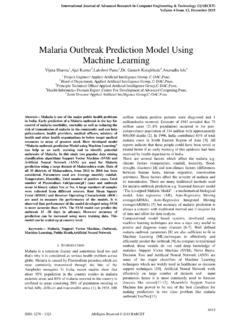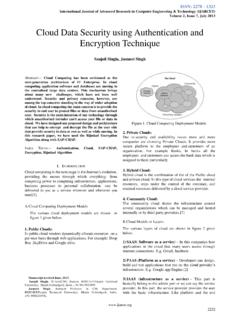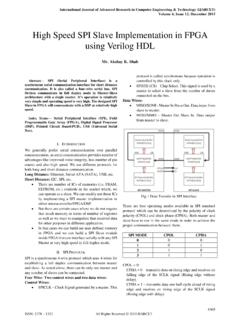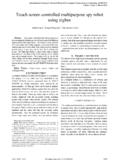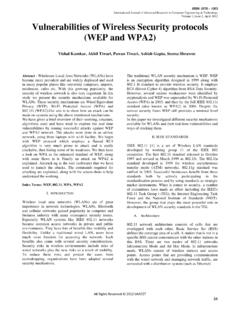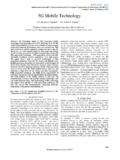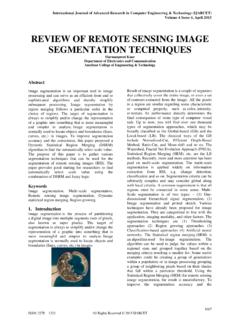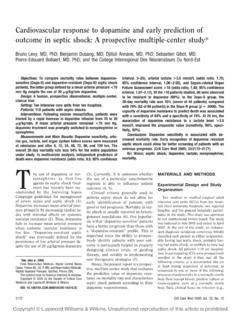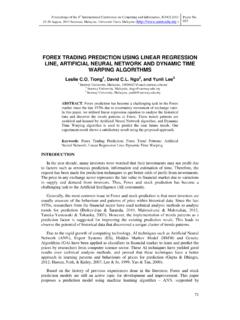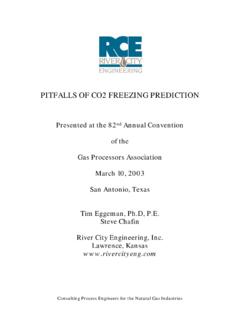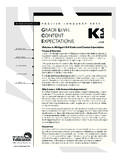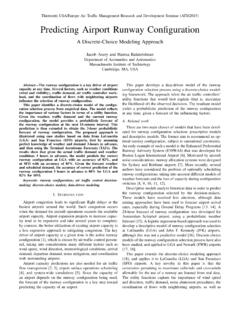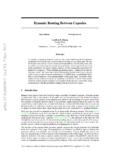Transcription of Cardiac Risk Prediction Analysis Using Spark Python (PySpark)
1 ISSN: 2278 1323 International Journal of Advanced Research in Computer Engineering & Technology (IJARCET) Volume 5, Issue 9, September 2016 2366 All Rights Reserved 2016 IJARCET Abstract-Cardiovascular disease is the acute disorder in the world today. Disease control and early diagnosis of disorder can prevent from death and other diseases. Several techniques have been developed for assessment of Cardiac risk Using structured and unstructured patient data. Coronary Artery Disease(CAD) is predominated disorder occurs due to several parameters such as cholesterol level, Blood pressure, sugar levels, smoking status, age and family history. Usually data is very crucial for Prediction of the risk and data is available in many formats such as structured, semi structured and unstructured data, among the data formats unstructured data is vital and risk factor parameters are embedded in it.
2 This work presents an automatic method, which extracts clinical, physical and other parameters from unstructured data and these are used for predicting the Cardiac disease risk and analyzed risk Prediction methods such as Framingham, Reynolds and Prospective Cardiovascular Munster (PROCAM) Using Spark with Python ((PySpark). Study observes Reynolds risk Prediction method shows high sensitivity and specificity than other methods. So Reynolds risk Prediction method provides better screening tool for both men and women to know the Cardiac diseases and helps the patients that CAD can be prevented and controlled. It also provides statistical data of these methods to researchers and organizations. Keywords- Accuracy, Cardiac Risk, Prediction , PySpark, Sensitivity.)
3 I. INTRODUCTION Cardiovascular disease is the leading global cause of death, accounting for more than million deaths per year, a G. Tirupati, Department of Information Technology, GVP College of Engineering for Women, Visakhapatnam, India. Prof. Rao, Department of Computer Science & Systems Engineering, Andhra University College of Engineering, Visakhapatnam, India. number that is expected to grow to more than million by 2030[1]. Coronary Artery Disease (CAD) is the most common type of heart disease and leading cause of death in both men and women. CAD happens when the arteries that supply blood to heart muscle become hardened and narrowed their inner walls. This build-up is called atherosclerosis. It is due to the build up of cholesterol and other material, called plaque, on as it grows, less blood can flow through the arteries.
4 As a result, the heart muscle can't get the blood or oxygen it needs. This can lead to chest pain or a heart attack. So prevention and control of this is vital in health care. It can be determined by various Prediction methods, which is useful for both patient and clinician. CAD risk assessment is part of various national and international guidelines [2], and various risk assessment methods are existed for different age groups. One of the risk assessments is Framingham technique, which gives the guidelines for determining the 10-year risk factor both for men and women in the age group 30-64. One of the studies presents a rule based procedure for how to assess the risk Using unstructured electronic records Using text mining system [3]. Hui Yang described hybrid system to automatically identify the risk factors for heart disease [4], but both the methods have certain limitations.
5 Now a day s big data in health care is vital role in analyzing the patient data Using different analytic platforms [5]. A hadoop map reduce framework was proposed to analyze the major diseases such as diabetes and other disorders [6]. A systematic approach was developed to enhance known knowledge-based risk factors with additional potential risk factors derived from data. Systemic approach to enhance known knowledge based risk factors with additional risk factors derived from data [7]. A Congestive Heart Failure (CHF) case finding algorithm was developed, tested and prospectively validated. The successful integration of the CHF case findings algorithm into the Maine HIE live system is expected to improve the Maine CHF care[9] and A survey has been done on how big data analytics plays a role in predict the emergency situations before it happens [10].
6 A study shows comparison between Framingham risk scores and Reynolds risk score Prediction [11]. But both methods use manual process for extracting the parameters. Evaketole and tiira laatikainen presented a paper on how do different cardiovascular risk scores act in real life [12], in this work sensitivity and specificity of risk charts based on Framingham, SCORE and CVD risk score. But these risk scores were manually calculated. Another study sharmini and selvarajah and gurpreet kaur presented work on comparison of the Framingham risk, SCORE and WHO/ISH Cardiac Risk Prediction Analysis Using Spark Python (PySpark) , Prof. Rao ISSN: 2278 1323 International Journal of Advanced Research in Computer Engineering & Technology (IJARCET) Volume 5, Issue 9, September 2016 2367 All Rights Reserved 2016 IJARCET cardiovascular risk Prediction models in an asian population [13].
7 SCORE high model predict risk accurately in men but underestimated women. A work presents how Reynolds risk scores effects based on c - reactive protein and family history [14]. II. MATERIALS AND METHODS A. Data Data is vital for risk Prediction and further Analysis . Most of the data available in unstructured format it is also known as clinical notes (unstructured). Clinical notes contain rich and diverse source of information. Challenges for handling clinical notes grammatical, short phrases, Abbreviations, Misspellings, Semi-structured information. Unstructured patient data (also known corpus) available or gets from the informatics for integrating biology & the bedside (i2b2) track2 for identifying the risk assessment. XML data file contains elements both text and attributes.
8 These elements describe patient information about present and past status as well as physical and clinical parameters. Data gets from informatics for integrating biology & bedside (i2b2) contains 53 xml files, some files already having CAD (abnormal) and remaining are normal. Each data file contains patient details such as medication, laboratory results, medical history and personal information (age, weight). Figure 1 shows how analytics can be used in healthcare. Fig. 1 Model of Health Care Analytics CAD risk parameters such as personal information, laboratory results and medical history mined from these data files Using natural language processing tool kit. B. Methods It is automatic Cardiac risk Prediction method, which extracts physical, clinical and family history, in which Framingham risk Prediction is one of the rule based technique depends on patient age, total cholesterol, High Density Lipoprotein (HDL) cholesterol, systolic Blood Pressure (BP), Treatment for hypertension and smoking status.
9 Each parameter has some score points and numbers of points are based on range of the parameter and again these are different for men and women. All points are added and final risk score is determined by the total number of points. Figure 2 shows data file, which contains text and tags. automatic Technique , which extracts the physical and clinical parameters from data file. It contains gender may be male or female or M or F and age also represented either years or Y. Some of attributes , for exmaple smoking parameter can be extracted based on status as shown in Fig. 2 Patient Data Structure so all required paramets extracted used for predicting the risk method Reynolds risk score can be determined Using a computational formula for both men and women.
10 A 10-year cardiovascular disease for men can be estimated Using equation (1) and equation (2) used for evaluating the risk for women. Where B = ln (age) + ln (BP) + ln (Total cholesterol) ln (HDL) + (if current smoker) + ln (HSCRP) + (Parental History). Where B = (age) + ln (BP) + ln (Total cholesterol) ln (HDL) + (if current smoker) + ln (HSCRP) + (Parental History). Another simple method for calculating risk is 10-year prospective cardiovascular munster (PROCAM) study based on age, blood pressure, LDL cholesterol and HDL cholesterol and triglycerides. All scores are categorized into three groups , low if it is <10%, moderate if risk score is in 10-20% range, and high if the risk score is >20%.
